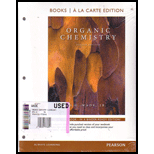
Interpretation:
The stereoisomer required to obtain the given products in presence of
Concept introduction:
Addition Reaction: It is defined as
In addition reaction of
Stereoisomers: Two compounds with same molecular formula but different in their orientation are considered as isomers.
The presence of atom with non-super impossible mirror image is defined as enantiomers which are given
Meso compound: The compound with chiral carbon that also have plane of symmetry which actually makes the compound achiral that does not have an enantiomer (Non-superimposable mirror images).
R and S nomenclature: it is used to assign the molecule using CIP rules.
The CIP rules are as follows:
Select the chiral carbon and assign the numbers according to the decreasing
If the numbering follows clockwise direction then the molecule is termed as R and if it follows anti-clockwise direction then molecule is termed as S.
Want to see the full answer?
Check out a sample textbook solution
Chapter 6 Solutions
Organic Chemistry, Books A La Carte Edition (8th Edition)
- Which isomer reacts more rapidly in an E2 reaction: cis-1-bromo-4-tert-butylcyclohexane or trans-1bromo-4-tert-butylcyclohexane? Explain your answer.arrow_forwardWhen Br2 is added to buta-1,3-diene at -15 °C, the product mixture contains 60% ofproduct A and 40% of product B. When the same reaction takes place at 60 °C, theproduct ratio is 10% A and 90% B.Show why A predominates at -15 °C and B predominates at 60 °C.arrow_forwardWhen buta-1,3-diene (CH2 = CH – CH = CH2) is treated with HBr, two constitutional isomers are formed, CH3CHBrCH = CH2 and BrCH2CH = CHCH3. Draw a stepwise mechanism that accounts for the formation of both products.arrow_forward
- Benzene is one of the compounds used as octane enhancers in unleaded gasoline. It is manufactured by thecatalytic conversion of acetylene to benzene: 3C2 H2(g) ⇌ C6 H6(g). Which value of Kc would make this reactionmost useful commercially? Kc ≈ 0.01, Kc ≈ 1, or Kc ≈ 10. Explain your answerarrow_forwarda.What product(s) (excluding stereoisomers) are formed when Y is heated with Cl2? b.What product(s) (excluding stereoisomers) are formed when Y is heated with Br2? c.What steps are needed to convert Y to the alkene Z?arrow_forwardStereoisomers of α-bromocinnamic acid: draw the reaction mechiansim with arows for the dehydrobromination of 2,3-dibromo-3-phenylpropanoic acid with ethanol and KOH to produce (Z)-α-bromocinnamic acid and (E)-α-bromocinnamic acid. Also draw the transition state for The (Z)-isomer syn-periplanar transition state and anti-periplanar transition state of the (E)-isomer.arrow_forward
- Explain how the reaction of (CH3)2CHCH(Cl)CH3 with H2O yields two substitutionproducts, (CH3)2CHCH(OH)CH3 and (CH3)2C(OH)CH2CH3arrow_forwardDoes cis- or trans-1-bromo-4-tert-butylcylohexane react faster in an E2reaction?arrow_forwardA)Circle all of the stereo centers in MDMA. B) assign the absolute stereochemistry (R or S) for each stereo centerarrow_forward
- 7 Explain the stereochemistry of E2 eliminations to form alkenes, and predict theproducts of E1 reactions on stereoisomers and on cyclohexane systemsarrow_forwardArrange the alkyl halides in order of increasing reactivity in an SN2 reaction with KI in acetone (least first). I, IV, III, II II, III, I, IV IV, I, III, II III, II, IV, Iarrow_forward(R)-2-chloropentane was reacted with NaSCH3. The compound yielded 65% (S)-2-chloropentane with the enantiomer making up the other 35%. Which mechanism was followed in the reaction? Both, more SN2 Both, more SN1 SN1 SN2arrow_forward

 EBK A SMALL SCALE APPROACH TO ORGANIC LChemistryISBN:9781305446021Author:LampmanPublisher:CENGAGE LEARNING - CONSIGNMENT
EBK A SMALL SCALE APPROACH TO ORGANIC LChemistryISBN:9781305446021Author:LampmanPublisher:CENGAGE LEARNING - CONSIGNMENT

